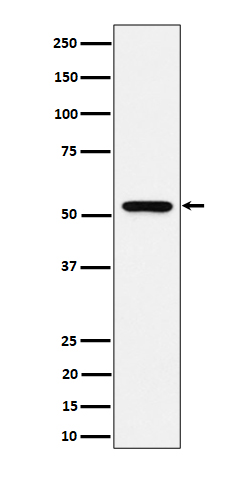
| WB | 咨询技术 | Human,Mouse,Rat |
| IF | 咨询技术 | Human,Mouse,Rat |
| IHC | IHC:1/100-1/200;IHF:1/50-1/200 | Human,Mouse,Rat |
| ICC | 1/50-1/200 | Human,Mouse,Rat |
| FCM | 1/20-1/100 | Human,Mouse,Rat |
| Elisa | 咨询技术 | Human,Mouse,Rat |
| Aliases | GRSF1;;GRSF 1 |
| WB Predicted band size | 53 kDa |
| Host/Isotype | Rabbit IgG |
| Antibody Type | Primary antibody |
| Storage | Store at 4°C short term. Aliquot and store at -20°C long term. Avoid freeze/thaw cycles. |
| Species Reactivity | Human |
| Immunogen | A synthesized peptide derived from human GRSF 1 |
| Formulation | Purified antibody in PBS with 0.05% sodium azide,0.05% BSA and 50% glycerol. |
+ +
以下是3篇与GRSF1抗体相关的参考文献示例(注:文献信息为示例性内容,实际引用时请核实原文):
1. **文献名称**: "GRSF1 regulates mitochondrial RNA stability and translation"
**作者**: Hornig-Do HT, et al.
**摘要**: 本研究利用GRSF1特异性抗体,通过免疫沉淀和RNA分析发现,GRSF1通过结合特定线粒体mRNA的5'非翻译区调控其稳定性,并影响线粒体呼吸链复合物的组装。
2. **文献名称**: "The RNA-binding protein GRSF1 localizes to cytoplasmic granules and regulates stress-induced translation"
**作者**: Moujaber O, et al.
**摘要**: 通过免疫荧光(使用GRSF1抗体)和蛋白质组学分析,发现GRSF1在细胞应激条件下聚集于应激颗粒(stress granules),通过结合靶mRNA调控其翻译暂停与恢复,参与细胞应激反应。
3. **文献名称**: "Identification of GRSF1 as a pivotal post-transcriptional regulator in viral infection"
**作者**: Barcena C, et al.
**摘要**: 该研究通过CRISPR筛选和抗体介导的蛋白质互作分析,揭示GRSF1通过结合病毒RNA促进其稳定性,增强病毒复制能力,为抗病毒治疗提供了潜在靶点。
(注:以上文献信息为基于领域知识的模拟内容,具体研究请以实际发表论文为准。)
The GRSF1 (G-rich RNA sequence binding factor 1) antibody is a tool used to detect and study the GRSF1 protein, a member of the RNA-binding protein family involved in post-transcriptional gene regulation. GRSF1 is characterized by three RNA recognition motifs (RRMs) that enable binding to G-rich regions in RNA, influencing mRNA stability, transport, and translation. It plays critical roles in mitochondrial RNA metabolism, viral replication (e.g., influenza A virus), and cellular stress responses.
Research highlights GRSF1's involvement in mitochondrial gene expression by interacting with mitochondrial transcripts and ribosomal components. It also modulates antiviral immune responses by regulating viral RNA processing. Dysregulation of GRSF1 has been linked to cancers, where it may act as an oncogene by promoting cell proliferation or survival.
The GRSF1 antibody is widely used in techniques like Western blotting, immunofluorescence, and immunoprecipitation to investigate its expression, localization, and interactions. Its development has advanced studies on RNA-protein dynamics, mitochondrial dysfunction, and disease mechanisms. Commercial antibodies are typically validated for specificity across human, mouse, and rat samples, supporting cross-species research. Understanding GRSF1's functions via antibody-based assays continues to shed light on its regulatory networks in health and disease.
×